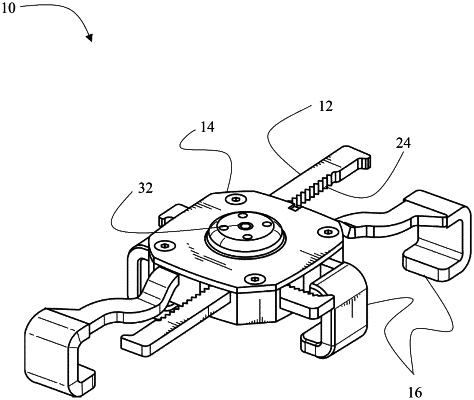| CPC E05B 73/0082 (2013.01) [E05B 47/0001 (2013.01); E05B 73/0017 (2013.01); E05B 73/0023 (2013.01); E05B 2047/002 (2013.01)] | 21 Claims |

|
1. An anti-theft device for securing an article of merchandise, comprising:
a housing having a top suffice configured to be proximal to the article of merchandise and a bottom surface opposite the top surface;
a plurality of arms connected to the housing, wherein at least a first arm of the plurality of arms is in a sliding relationship relative to the housing, wherein a length of the first arm extending beyond the housing is adjustable by sliding the first arm inwardly or outwardly with respect to the housing;
a grip disposed at an end of the first arm, the grip configured to receive a corner or an edge of the article of merchandise;
a first set of teeth disposed along the first arm;
a locking component slidingly disposed within the housing a non-rotational relationship thereto, wherein the locking component is transitionable between a first disengaged position and a second engaged position, wherein, in the second engaged position, the locking component exerts a force onto the first arm causing the first set of teeth disposed along the first arm to be interlocked with a second set of teeth, wherein the length of the first arm extending beyond the housing cannot be adjusted when the first and the second sets of teeth are interlocked; and
a first mechanical element disposed within the housing, wherein the first mechanical element has a first configuration in which the first mechanical element is configured to immobilize the locking component in the second engaged position, and wherein the first mechanical element has a second configuration in which the first mechanical element releases the locking component, thereby enabling the locking component to retract into the first disengaged position, in which the locking component is retracted away from the first arm, thereby enabling, the first set of teeth to disengage the second set of teeth, thereby releasing the first arm to slide inwardly or outwardly with respect to the housing to adjust the length of the first arm extending beyond the housing.
|